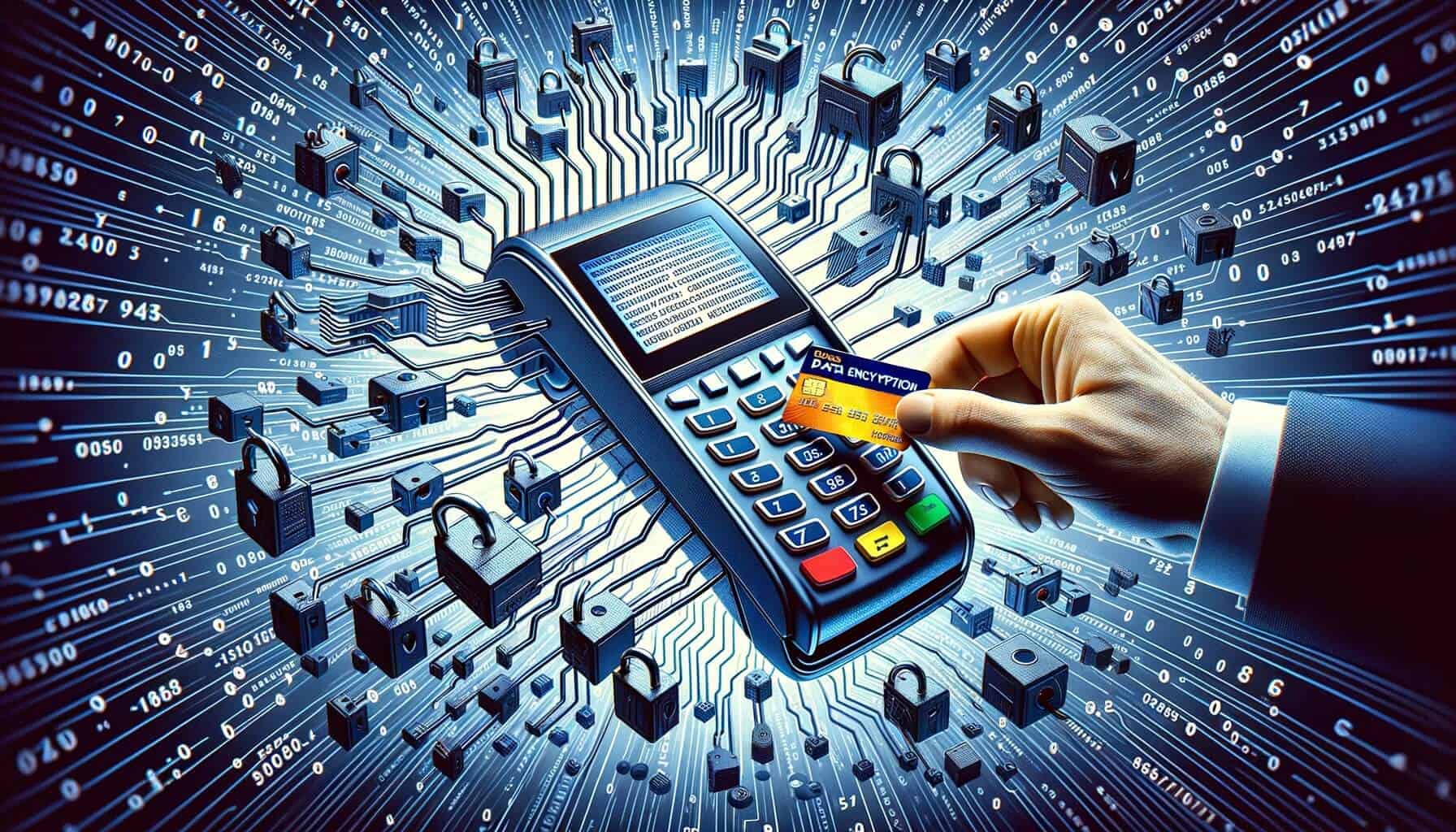
By Catharine Proctor February 23, 2025
In today’s digital age, where financial transactions are increasingly conducted electronically, the security of payment terminals has become a paramount concern. Payment terminals, also known as point-of-sale (POS) terminals, are devices used by merchants to process payments from customers. These terminals play a crucial role in ensuring the confidentiality and integrity of sensitive transaction data, such as credit card numbers and personal identification numbers (PINs). One of the key mechanisms employed by payment terminals to safeguard this data is encryption.
Encryption is the process of converting plaintext data into ciphertext, which can only be deciphered with the use of a secret key. In the context of payment terminals, encryption is used to protect sensitive information during transmission and storage, making it virtually impossible for unauthorized individuals to access or manipulate the data.
This article aims to provide a comprehensive understanding of how payment terminals handle encryption during transactions, exploring the basics of encryption, the role it plays in securing transaction data, the different types of encryption algorithms used, key management practices, the encryption and decryption process, compliance with industry standards, common challenges and vulnerabilities, and best practices for implementing and maintaining payment terminal encryption.
Understanding the Basics of Encryption in Payment Terminals

Encryption is a fundamental concept in information security, and its application in payment terminals is no exception. At its core, encryption relies on mathematical algorithms to transform plaintext data into ciphertext, rendering it unreadable to anyone without the appropriate decryption key. This process ensures that even if an attacker intercepts the encrypted data, they would be unable to decipher its contents without the key.
In the context of payment terminals, encryption is primarily used to protect sensitive information during transmission between the terminal and the acquiring bank or payment processor. This is particularly important in scenarios where transactions are conducted over insecure networks, such as the internet. By encrypting the data, payment terminals ensure that even if it is intercepted by an attacker, it remains unintelligible and useless.
The Role of Encryption in Securing Transaction Data

The role of encryption in securing transaction data cannot be overstated. Payment terminals handle a vast amount of sensitive information, including credit card numbers, PINs, and other personal data. Without encryption, this data would be vulnerable to interception and misuse, potentially leading to financial loss and identity theft.
Encryption provides a robust defense against unauthorized access to transaction data. By encrypting the data at the point of capture, payment terminals ensure that even if an attacker gains physical access to the device or intercepts the data during transmission, they would be unable to decipher it without the encryption key. This significantly reduces the risk of data breaches and unauthorized access to sensitive information.
Different Types of Encryption Algorithms Used in Payment Terminals

Encryption algorithms are the mathematical formulas used to transform plaintext data into ciphertext. There are several encryption algorithms commonly used in payment terminals, each with its own strengths and weaknesses. Let’s explore some of the most widely used encryption algorithms in the context of payment terminal security.
1. Advanced Encryption Standard (AES): AES is a symmetric encryption algorithm widely regarded as one of the most secure and efficient encryption algorithms available today. It supports key sizes of 128, 192, and 256 bits, making it suitable for a wide range of applications, including payment terminal encryption. AES has been adopted as the standard encryption algorithm by the U.S. government and is widely used in various industries, including finance and healthcare.
2. Triple Data Encryption Standard (3DES): 3DES is a symmetric encryption algorithm that applies the Data Encryption Standard (DES) algorithm three times to each data block. While 3DES is considered secure, it is relatively slower and less efficient compared to AES. However, due to its compatibility with legacy systems, 3DES is still widely used in payment terminals and other applications.
3. Rivest Cipher (RC) Algorithms: The RC family of encryption algorithms, including RC2, RC4, and RC5, were developed by renowned cryptographer Ron Rivest. RC4, in particular, gained popularity due to its simplicity and speed. However, RC4 is no longer considered secure and has been deprecated in many applications, including payment terminals. RC2 and RC5 are still used in some legacy systems but have largely been replaced by more secure algorithms.
4. Elliptic Curve Cryptography (ECC): ECC is a public-key encryption algorithm that offers strong security with relatively shorter key lengths compared to traditional algorithms like RSA. ECC is gaining popularity in payment terminals due to its efficiency and suitability for resource-constrained devices. It is particularly well-suited for securing transactions conducted over mobile payment platforms.
Key Management in Payment Terminal Encryption

Key management is a critical aspect of payment terminal encryption. Encryption keys are the secret codes used to encrypt and decrypt data, and their proper management is essential to ensure the security and integrity of transaction data. Key management encompasses various processes, including key generation, distribution, storage, rotation, and revocation.
1. Key Generation: Encryption keys must be generated using secure random number generators to ensure their unpredictability. Payment terminals typically generate encryption keys during the initialization process, and these keys are used to encrypt the sensitive data captured during transactions.
2. Key Distribution: Once generated, encryption keys need to be securely distributed to the relevant parties, such as the acquiring bank or payment processor. This is typically done using secure channels, such as encrypted connections or physical delivery of secure hardware modules.
3. Key Storage: The secure storage of encryption keys is crucial to prevent unauthorized access. Payment terminals employ various mechanisms to protect the keys, such as hardware security modules (HSMs) or secure elements embedded within the terminal. These mechanisms ensure that the keys are securely stored and cannot be easily extracted or tampered with.
4. Key Rotation: Regular key rotation is essential to maintain the security of payment terminal encryption. By periodically changing encryption keys, payment terminals mitigate the risk of compromised keys being used to decrypt sensitive data. Key rotation also helps in complying with industry standards and regulations that mandate regular key updates.
5. Key Revocation: In the event of a compromised key or a security breach, it is crucial to revoke and replace the affected encryption keys. This ensures that any data encrypted with the compromised key remains secure and cannot be decrypted by unauthorized individuals.
The Process of Encryption and Decryption in Payment Terminals
The process of encryption and decryption in payment terminals involves several steps to ensure the secure handling of sensitive transaction data. Let’s explore the key stages of this process.
1. Data Capture: The encryption process begins with the capture of sensitive transaction data, such as credit card numbers and PINs, by the payment terminal. This data is typically entered by the customer using a keypad or swiped through a card reader.
2. Encryption: Once the data is captured, the payment terminal encrypts it using the encryption key. The encryption algorithm transforms the plaintext data into ciphertext, rendering it unreadable to anyone without the decryption key.
3. Transmission: The encrypted data is then transmitted from the payment terminal to the acquiring bank or payment processor. This transmission can occur over various channels, such as wired or wireless connections, depending on the type of payment terminal and the network infrastructure in place.
4. Decryption: Upon receiving the encrypted data, the acquiring bank or payment processor uses the corresponding decryption key to decrypt the ciphertext and recover the original plaintext data. This decryption process is typically performed within a secure environment, such as a secure server or hardware security module.
5. Authorization and Processing: Once the data is decrypted, the acquiring bank or payment processor verifies the authenticity and integrity of the transaction data. This involves checking the validity of the decrypted data, performing fraud detection checks, and authorizing the transaction if it meets the necessary criteria. If the transaction is approved, the payment processor initiates the necessary financial transfers and updates the relevant records.
Ensuring Compliance with Industry Standards for Payment Terminal Encryption
The security of payment terminals and the encryption mechanisms they employ are subject to various industry standards and regulations. Compliance with these standards is essential to ensure the integrity and confidentiality of transaction data. Let’s explore some of the key industry standards and regulations related to payment terminal encryption.
1. Payment Card Industry Data Security Standard (PCI DSS): PCI DSS is a set of security standards established by the Payment Card Industry Security Standards Council (PCI SSC) to protect cardholder data. Compliance with PCI DSS is mandatory for any organization that handles payment card data, including merchants, payment processors, and acquiring banks. PCI DSS includes specific requirements for encryption, such as the use of strong encryption algorithms, secure key management practices, and regular key rotation.
2. Europay, Mastercard, and Visa (EMV): EMV is a global standard for secure payment transactions that uses chip-based payment cards and payment terminals. EMV incorporates various security features, including encryption, to protect against card fraud and counterfeit transactions. EMV-compliant payment terminals use encryption to secure the communication between the terminal and the chip on the payment card, ensuring the integrity and confidentiality of transaction data.
3. Payment Application Data Security Standard (PA-DSS): PA-DSS is a set of security requirements established by the PCI SSC for software vendors that develop payment applications. PA-DSS ensures that payment applications meet specific security standards, including encryption requirements, to protect cardholder data. Compliance with PA-DSS is necessary for payment applications to be listed on the PCI SSC’s list of validated payment applications.
4. General Data Protection Regulation (GDPR): GDPR is a regulation enacted by the European Union (EU) to protect the privacy and personal data of EU citizens. While not specific to payment terminals, GDPR imposes strict requirements on the handling of personal data, including encryption as a means to protect data confidentiality. Organizations that process personal data, including payment terminals that handle customer information, must comply with GDPR’s encryption requirements to avoid hefty fines and reputational damage.
Common Challenges and Vulnerabilities in Payment Terminal Encryption
While encryption plays a crucial role in securing payment terminals, there are several challenges and vulnerabilities that organizations must address to ensure the effectiveness of their encryption mechanisms. Let’s explore some of the common challenges and vulnerabilities associated with payment terminal encryption.
1. Weak Encryption Algorithms: The choice of encryption algorithm is critical to the security of payment terminal encryption. Weak or outdated encryption algorithms, such as the deprecated RC4 algorithm, can be vulnerable to attacks and compromise the confidentiality of transaction data. Organizations must ensure that they use strong encryption algorithms, such as AES, and keep up with advancements in encryption technology to mitigate the risk of vulnerabilities.
2. Insecure Key Management: Key management is a complex process that requires careful attention to ensure the security of encryption keys. Inadequate key generation, distribution, storage, rotation, or revocation practices can lead to compromised keys and unauthorized access to sensitive data. Organizations must implement robust key management practices, including the use of secure hardware modules and regular key rotation, to mitigate the risk of key-related vulnerabilities.
3. Physical Security: Payment terminals are susceptible to physical attacks, such as tampering or theft, which can compromise the security of encryption mechanisms. Attackers may attempt to extract encryption keys or install malicious hardware or software to intercept sensitive data. Organizations must implement physical security measures, such as tamper-evident seals, secure enclosures, and surveillance systems, to protect payment terminals from physical attacks.
4. Insider Threats: Insider threats pose a significant risk to the security of payment terminal encryption. Employees with authorized access to payment terminals may misuse their privileges to gain unauthorized access to sensitive data or compromise encryption mechanisms. Organizations must implement strict access controls, monitor user activities, and conduct regular security awareness training to mitigate the risk of insider threats.
5. Lack of Compliance: Failure to comply with industry standards and regulations, such as PCI DSS or EMV, can expose payment terminals to vulnerabilities and compromise the security of transaction data. Non-compliance may result in financial penalties, loss of customer trust, and reputational damage. Organizations must prioritize compliance with relevant standards and regulations and regularly assess their security controls to ensure ongoing compliance.
Best Practices for Implementing and Maintaining Payment Terminal Encryption
Implementing and maintaining effective payment terminal encryption requires adherence to best practices that address the challenges and vulnerabilities discussed earlier. Let’s explore some of the best practices organizations should consider when implementing and maintaining payment terminal encryption.
1. Use Strong Encryption Algorithms: Organizations should use strong encryption algorithms, such as AES, to ensure the confidentiality and integrity of transaction data. Regularly review encryption algorithms to stay up to date with advancements in encryption technology and retire any weak or deprecated algorithms.
2. Implement Robust Key Management Practices: Establish comprehensive key management practices that cover key generation, distribution, storage, rotation, and revocation. Use secure random number generators for key generation, employ secure channels for key distribution, store keys in hardware security modules or secure elements, regularly rotate keys, and revoke compromised keys promptly.
3. Secure Physical Access to Payment Terminals: Protect payment terminals from physical attacks by implementing physical security measures. Use tamper-evident seals to detect tampering, secure payment terminals in enclosures that prevent unauthorized access, and deploy surveillance systems to monitor the physical environment.
4. Implement Access Controls and User Monitoring: Implement strict access controls to limit access to payment terminals and sensitive data only to authorized individuals. Monitor user activities to detect and respond to any suspicious or unauthorized behavior. Regularly review and update access privileges to ensure that only necessary personnel have access to payment terminals.
5. Regularly Update and Patch Payment Terminal Software: Keep payment terminal software up to date by regularly applying security patches and updates. Outdated software may contain vulnerabilities that can be exploited by attackers. Implement a robust patch management process to ensure timely updates and minimize the risk of software-related vulnerabilities.
6. Conduct Regular Security Assessments: Regularly assess the security controls and practices related to payment terminal encryption. This includes conducting vulnerability assessments, penetration testing, and security audits to identify and address any weaknesses or vulnerabilities. Regular assessments help organizations stay proactive in addressing emerging threats and maintaining a strong security posture.
7. Provide Security Awareness Training: Educate employees about the importance of payment terminal security and the role they play in maintaining it. Provide regular security awareness training to ensure that employees are aware of best practices, understand potential threats, and know how to respond to security incidents. A well-informed workforce is a crucial defense against social engineering attacks and insider threats.
FAQs
Q1: How does encryption protect payment data?
A1: Encryption converts payment data into an unreadable format, making it virtually impossible for unauthorized individuals to decipher the information.
Q2: What encryption algorithms are commonly used in payment terminals?
A2: Commonly used encryption algorithms in payment terminals include AES, 3DES, and RC4.
Q3: What is key management in payment terminal encryption?
A3: Key management involves the secure generation, storage, and distribution of encryption keys to ensure the integrity of the encryption process.
Q4: What industry standards govern payment terminal encryption?
A4: The PCI DSS sets forth requirements for the secure handling of cardholder data, including encryption, in payment terminals.
Conclusion
Payment terminal encryption is a critical component of securing electronic transactions and protecting sensitive data. Encryption ensures the confidentiality and integrity of transaction data by rendering it unreadable to unauthorized individuals.
By understanding the basics of encryption, the role it plays in securing transaction data, the different types of encryption algorithms used, key management practices, the encryption and decryption process, compliance with industry standards, common challenges and vulnerabilities, and best practices for implementation and maintenance, organizations can enhance the security of their payment terminals.